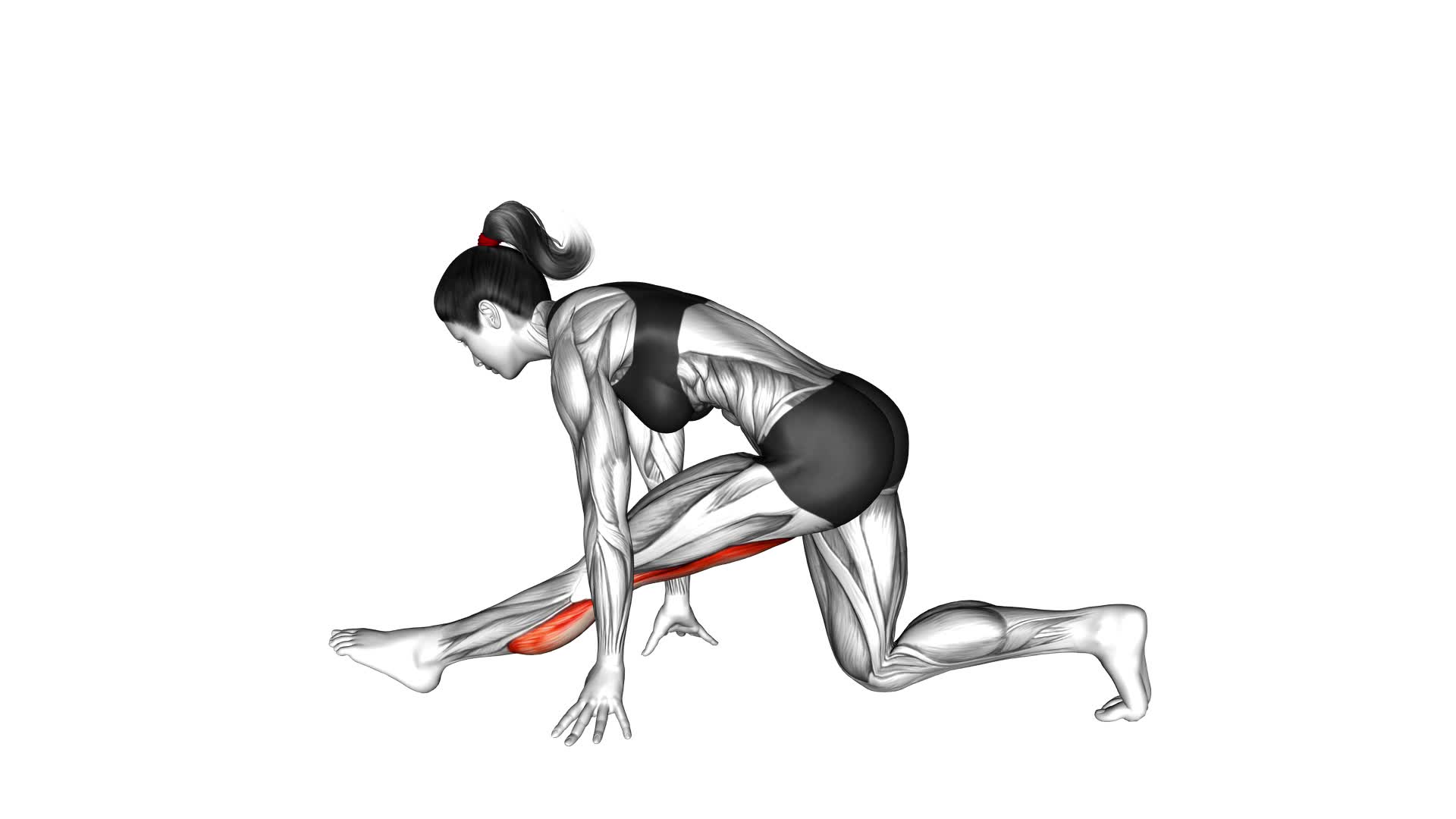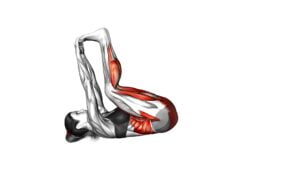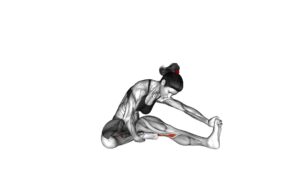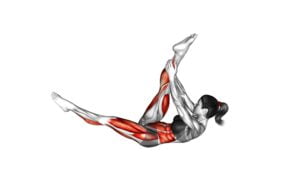Single Leg Calve Stretch (female) – Video Exercise Guide & Tips

Looking to stretch your calves and improve flexibility? Check out this video exercise guide for the single leg calve stretch.
Watch This Exercise Video
In this guide, you'll find tips and techniques to perform the stretch correctly, as well as common mistakes to avoid.
Whether you're a fitness enthusiast or just starting out, this stretch can be incorporated into your workout routine to target and strengthen your calves.
Get ready to feel the burn and see results!
Key Takeaways
- Increased flexibility in calf muscles
- Dynamic exercise targeting calf muscles
- Helps prevent injuries related to tight calf muscles
- Enhances overall lower body performance
Benefits of the Single Leg Calve Stretch
You will experience increased flexibility in your calf muscles by performing the single leg calf stretch. This stretch is a dynamic exercise that targets the calf muscles and helps to improve their range of motion. Unlike static stretches, which involve holding a stretch for a prolonged period, dynamic stretches involve moving through a range of motion. This movement helps to warm up the muscles and prepare them for physical activity.
There are different variations of the single leg calf stretch that you can incorporate into your workout routine. One variation is the standing single leg calf stretch, where you stand facing a wall and place one foot behind you, keeping the heel on the ground. You then lean forward, feeling a stretch in the calf of the extended leg.
Another variation is the seated single leg calf stretch, where you sit on the ground with one leg extended in front of you. You then reach towards your toes, feeling a stretch in the calf of the extended leg.
Incorporating dynamic stretches like the single leg calf stretch into your fitness routine can help improve your calf flexibility and overall performance. By incorporating different variations of this stretch, you can target different areas of your calf muscles and further enhance their flexibility.
Proper Form and Technique
To perform the single leg calf stretch with proper form and technique, it's important to pay attention to foot placement, alignment, and body positioning.
Make sure your foot is fully planted on the ground, with your toes pointing forward.
Keep your body aligned and straight, avoiding any leaning or twisting.
Maintain a steady and controlled movement throughout the exercise to maximize its effectiveness.
Foot Placement Importance
Achieving proper form and technique during the single leg calve stretch requires careful attention to foot placement. Proper foot alignment is crucial for maximizing the effectiveness of the stretch and avoiding injuries.
When performing this exercise, make sure to place your foot flat on the ground, with your toes pointed forward. Avoid turning your foot inward or outward, as this can put unnecessary strain on your ankle and calf muscles.
To achieve optimal stretching, focus on keeping your heel down and pushing through the ball of your foot. This will help to target the calf muscles and promote a deeper stretch.
Remember to maintain proper foot placement throughout the entire duration of the exercise to ensure a safe and effective stretch.
Alignment and Body Positioning
To ensure proper form and technique during the single leg calf stretch, it's essential to focus on aligning your body and maintaining the correct positioning. Proper alignment and body positioning offer several benefits for this exercise.
Firstly, it helps target the calf muscles more effectively, allowing for a deeper stretch and improved flexibility. Additionally, aligning your body properly helps prevent strain or injury to other muscles or joints. It also promotes better balance and stability, enhancing overall performance during the stretch.
When performing the single leg calf stretch, make sure to keep your back straight, shoulders relaxed, and core engaged. Maintain a stable stance with the supporting leg and avoid leaning forward or backward.
Common Mistakes to Avoid
To avoid common mistakes during the single leg calf stretch, make sure to properly position your foot by aligning it with your hip. This will ensure that you're targeting the correct muscles and maximizing the stretch.
Additionally, be careful not to bounce excessively while performing the stretch, as this can lead to strain or injury. By maintaining control and focusing on proper form, you can effectively stretch your calf muscles without risking any harm.
Proper Foot Positioning
Avoid positioning your foot too far forward or too far back while performing the single leg calve stretch. Proper foot positioning is crucial for maximizing foot flexibility and calf muscle activation during this stretch.
To achieve the correct foot position, start by standing with your feet hip-width apart. Then, take a step forward with one foot, keeping your heel on the ground and toes pointing straight ahead. Make sure your weight is evenly distributed between both feet. This position allows for optimal stretch of the calf muscles without putting excessive strain on the foot or ankle.
By maintaining proper foot positioning, you can ensure that you're targeting the right muscles and getting the most out of your single leg calve stretch.
Now, let's move on to the next section about avoiding excessive bouncing.
Avoiding Excessive Bouncing
Maintain a steady and controlled movement throughout the single leg calve stretch, avoiding any excessive bouncing. Proper stretching technique is essential to prevent muscle strain and injury.
Bouncing during the stretch can lead to tension and stress on the muscles, increasing the risk of strains. To avoid this, focus on a smooth and controlled motion as you stretch your calf.
Start by standing upright with one foot slightly in front of the other. Keep your back straight and gently lean forward, feeling a stretch in the calf of your back leg. Hold the stretch for about 20-30 seconds, breathing deeply.
Modifications and Progressions
Make sure to incorporate different levels of difficulty into your single leg calf stretch routine to challenge yourself and continue making progress. There are several modifications and variations you can try to target different muscles and intensify the stretch.
One modification you can make is to use a step or elevated surface to increase the range of motion. Place the ball of your foot on the edge of the step, allowing your heel to hang off. This will provide a deeper stretch in the calf muscles.
Another modification is to add resistance to the stretch. You can do this by holding onto a dumbbell or using a resistance band. This will engage more muscles in the lower leg and increase the intensity of the stretch.
To progress the single leg calf stretch, you can try balancing on one leg without using any support. This will challenge your stability and strengthen the muscles in your lower leg.
Remember to listen to your body and only progress to more difficult variations when you feel comfortable and stable.
Incorporating modifications and progressions into your single leg calf stretch routine will help you continue to improve flexibility and strength in your calf muscles.
Tips for a Successful Stretch
To optimize your single leg calf stretch, focus on maintaining proper form and incorporating a slow and controlled movement. This will help improve flexibility and prevent injuries.
When performing the stretch, start by standing upright with your feet hip-width apart. Lift one leg off the ground, bending your knee slightly. Place the ball of your foot against a stable surface, such as a wall or step. Keep your back straight and engage your core muscles to maintain stability.
Slowly lean forward, allowing your body weight to shift onto the front foot. You should feel a stretch in your calf muscle. Hold this position for 20 to 30 seconds, breathing deeply and relaxing into the stretch.
Remember to avoid bouncing or jerking movements, as these can lead to injury. As you progress, you can increase the intensity of the stretch by moving further away from the wall or step.
Always listen to your body and stop if you experience any pain or discomfort. By following these tips, you can maximize the benefits of the single leg calf stretch and prevent injuries.
Incorporating the Single Leg Calve Stretch Into Your Workout Routine
To incorporate the single leg calf stretch into your workout routine, you can add it as a dynamic warm-up exercise before your lower body workouts. This stretch specifically targets the calf muscles and can help improve flexibility and prevent injuries.
To perform the single leg calf stretch, start by standing facing a wall or sturdy object for support. Extend one leg behind you, keeping it straight with the heel on the ground. Lean forward, pressing your hands against the wall, and exhale as you feel the stretch in your calf. Hold for 20-30 seconds, then switch legs and repeat.
Incorporating stretching techniques, such as the single leg calf stretch, into your workout routine can enhance your overall performance and help you achieve better results. Stretching before your workout can increase blood flow to the muscles, warm them up, and improve their range of motion. This can lead to better muscle activation during your exercises and reduce the risk of strains or pulls.
Additionally, incorporating variations of the calve stretch, such as performing it with a bent knee or adding a towel for added resistance, can increase the challenge and target different areas of the calf muscle. Remember to always listen to your body and stretch within your comfort zone.
Frequently Asked Questions
How Many Times a Week Should I Perform the Single Leg Calf Stretch?
To achieve optimal benefits from the single leg calf stretch, you should perform it regularly. The frequency of your stretching sessions will depend on your fitness goals and current level of flexibility.
It's generally recommended to do this stretch at least 2-3 times a week. However, if you're looking to improve your calf flexibility or recover from a calf injury, you may need to do it more frequently.
Remember to hold the stretch for about 30 seconds on each leg for best results.
Can I Do the Single Leg Calf Stretch if I Have a Calf Injury?
If you have a calf injury, it's important to take precautions when doing the single leg calf stretch.
It's best to consult with a healthcare professional before attempting any exercises. They can provide guidance on whether it's safe for you to do this stretch and may recommend alternative calf stretches that are more suitable for your injury.
Prioritizing your recovery is key to preventing further damage and promoting healing.
Is It Better to Perform the Single Leg Calf Stretch Before or After My Workout?
To get the most out of your workout, it's important to know when to do the single leg calf stretch. Performing it before your workout can help warm up your muscles and improve flexibility, reducing the risk of injury during your exercises.
Doing it after your workout can help to cool down and stretch out your calf muscles, promoting recovery and preventing tightness.
How Long Should I Hold the Stretch for Maximum Benefits?
For optimal benefits, hold the single leg calf stretch for about 30 seconds.
Stretching plays a crucial role in preventing injuries by increasing flexibility and range of motion. It helps lengthen the muscles, reducing the risk of strains or tears during physical activity.
By incorporating stretching into your routine, you can improve muscle function and enhance performance.
Can I Use a Towel or Resistance Band to Enhance the Stretch During the Exercise?
Yes, you can enhance the stretch during the exercise by using a towel or a resistance band. These modifications can help increase the intensity of the stretch and target your calf muscles more effectively.
By wrapping the towel or resistance band around your foot and pulling it towards you, you can create a deeper stretch.
Remember to listen to your body and only go as far as feels comfortable.
Conclusion
Incorporating the single leg calf stretch into your workout routine can provide numerous benefits. This includes improved flexibility, enhanced calf muscle strength, and reduced risk of injury.
By following proper form and technique, avoiding common mistakes, and incorporating modifications and progressions, you can maximize the effectiveness of this stretch.
Remember to listen to your body and adjust as needed. With consistent practice, the single leg calf stretch can help you achieve your fitness goals.

Author
Years ago, the spark of my life’s passion ignited in my mind the moment I stepped into the local gym for the first time. The inaugural bead of perspiration, the initial endeavor, the very first surge of endorphins, and a sense of pride that washed over me post-workout marked the beginning of my deep-seated interest in strength sports, fitness, and sports nutrition. This very curiosity blossomed rapidly into a profound fascination, propelling me to earn a Master’s degree in Physical Education from the Academy of Physical Education in Krakow, followed by a Sports Manager diploma from the Jagiellonian University. My journey of growth led me to gain more specialized qualifications, such as being a certified personal trainer with a focus on sports dietetics, a lifeguard, and an instructor for wellness and corrective gymnastics. Theoretical knowledge paired seamlessly with practical experience, reinforcing my belief that the transformation of individuals under my guidance was also a reflection of my personal growth. This belief holds true even today. Each day, I strive to push the boundaries and explore new realms. These realms gently elevate me to greater heights. The unique combination of passion for my field and the continuous quest for growth fuels my drive to break new ground.







